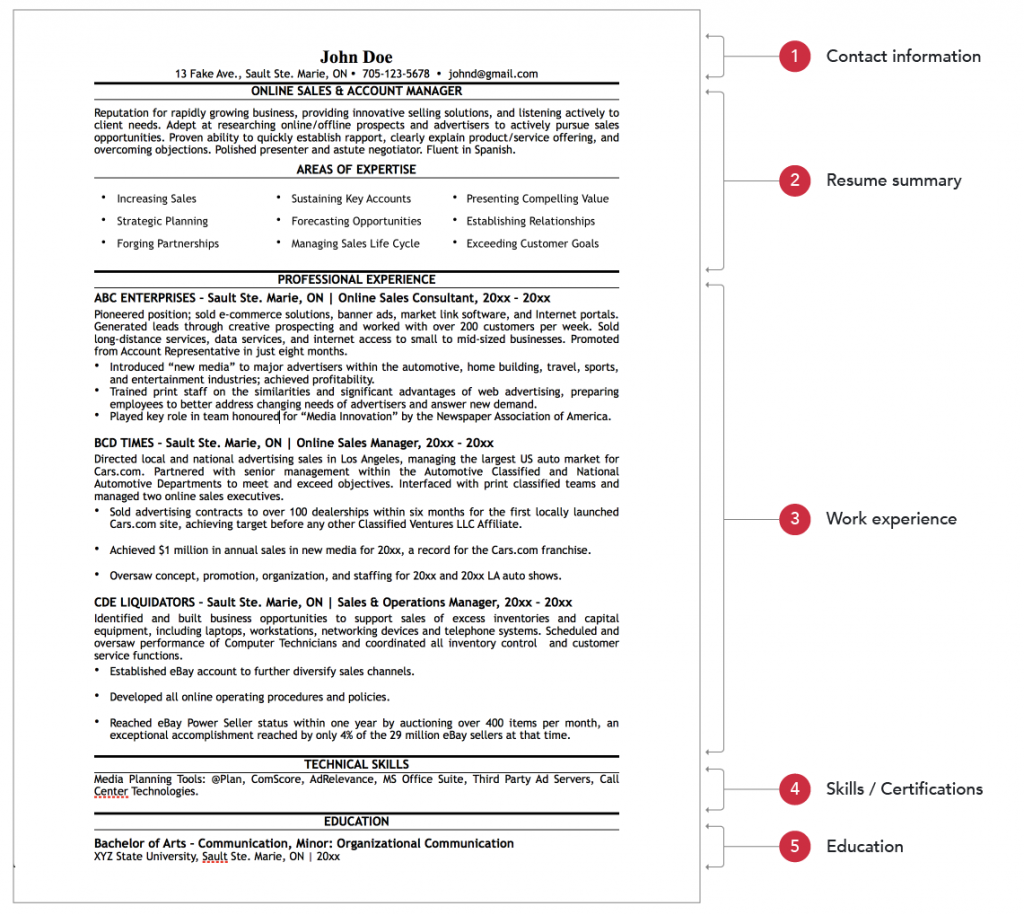For most newcomers in Canada, one of the top priorities is to find a job in the field of their choice. In this article, I will review my best practices for resume writing, which is one of the first steps in finding your dream job.
With this post, my objective is to help you create an impactful resume that aligns with the expectations of Canadian employers, makes you stand out from the crowd, and gets you noticed by hiring managers, thus landing yourself an interview. To accomplish this, I will guide you through my five step process to creating an impressive resume:
Step 1: Pick a resume format
There are 3 well-known types of resume formats, namely,
Reverse Chronological Resume – A reverse chronological resume may be used if someone is fairly experienced, has no large employment gaps, and intends to continue working in the same field. This format is widely used and preferred by many recruiters and job sites.
Free chronological resumes: Template 1, Template 2 (Click the link, then select the “Download” option at the top-right corner on your screen).
A Canadian Resume and Interview Trends survey conducted in 2010, had 54.7 per cent of the respondents vouch for the chronological format, making it the most popular format. In this post, we are going to focus on this template style but I also wanted to provide you with a recap of the other two most commonly used formats (along with some sample templates that you can download).
Combination Resume – A combination resume a mix of chronological and functional. A combination resume template is ideal if the intention is to highlight transferable skills while also showcasing work experience. It is very commonly used and caters to a variety of job seekers ranging from mature workers to those with limited experience while even considering those with employment gaps or many short-term work stints.
Free combination resumes: Template 1, Template 2, Template 3 (Click the link, then select the “Download” option at the top-right corner on your screen).
Functional Resume – A functional resume focuses on abilities and skills, rather than career progression. A functional resume template is preferred when one is switching careers, just entering the workforce, has gaps in their work history, or has frequently changed jobs. It works best when candidates have limited work history and want to keep the focus on the skills they have to offer.
Free functional resumes: Template 1, Template 2 (Click the link, then select the “Download” option at the top-right corner on your screen).
Step 2: Plan the anatomy of your resume
Now getting back to the chronological format, the resume can be divided into 5 major parts/sections:

Step 3: Fill in the details
Now that you have an outline of your resume, it’s time to fill in the details. Be mindful that on average it is recommended that your resume is ideally only one page long. Best practices outlined by Employment Ontario, Canada Job Bank, Glassdoor, as well as the Career Professional of Canada, all suggest using one page for every 10 years of experience, not exceeding two pages.
- Contact information
- Must include: Name, Canadian phone number, and (professional looking) email such as <FirstName.LastName@gmail.com>.
- Good to have: LinkedIn profile URL.
- Do not include your photograph.
- Resume summary
- May include: 3-4 line summary and relevant skill set. A good summary goes a long way in selling your skill-set and experience.
- Best to leave out career objective. The 2010 survey on Canadian resumes and Interview Trends highlighted that approximately 56% of the recruiters and hiring managers said that they preferred a summary statement or profile paragraph rather than an ‘objective’ statement.
- Work experience
- Each role/position should have 3 to 5 bullet points supporting it.
- Include a line about the company that you worked for (unless it is a well-known brand), talk about the company domain, and the size/business are they focused on.
- Regarding titles/designations : Research the market and translate your title corresponding to the market (for instance, if your title is that of a Vice President, while your actual job was managing a development team then you should put Team Lead in your title, not Vice President to provide clear representation of your experience).
- Work/professional experience should include title, the name of the organization, employment timeframe, and a brief snapshot of roles, responsibilities, and accomplishments in each role.
- Tailor your resume to suit the job description of the position you’re applying for; include keywords and always start your sentence with action verbs like ‘spearheaded’, ‘achieved’, ‘managed’, ‘trained’, etc. Here’s a list of action verbs you can use in your resume.
- Ensure that all accomplishments are quantified in some way. The ‘CAR’ approach always helps when you structure your sentence: C = what was the Challenge, A = what Action did you take, and R = what was the Result.
- Additional sections (such as Awards, Certifications, Publications, Skills, Volunteer Work etc.)
- These are optional and can be omitted if they are not relevant to the position or if they don’t carry much weight.
- Do not include personal awards, publications, hobbies etc.; keep it strictly professional.
- Education
- The highest qualification usually suffices, unless you have other qualifications that are relevant to the position you’re applying for. There’s no need to mention grades but do include the university name, location, and graduation year.
- For newcomers, it’s also worthwhile to add a line about the Canadian equivalency of your degree/diploma (reference: education credential evaluation by organizations like WES)
| Navigating the Canadian job market can be overwhelming. Arrive guides on Finding Your Career in Canada and the Canadian Job Market are a quick and concise overview that explains all the need-to-know information and action items you can take to prepare yourself for finding and landing a job opportunity in Canada. Download your copies now and fast-track your professional success! |
Step 4: Check the formatting, language fluency, grammar, punctuation, and spelling
Grammar, spelling, punctuation, and sentence formation is an area where most newcomers need help, especially since their first language is not English. To help with this, if you’re using Google Docs to create your resume, there are tools such as Grammarly that can be leveraged. If you’re using MS Word, there’s an inbuilt tool for checking grammar, spellings, and sentence formation. Be sure to use that before you finalize your resume.
You can use horizontal lines to provide a visual segregation of various sections of your resume. Browse through the resume samples linked above to get a better understanding of how to format your resume.
Choose an easy to read, professional, and widely accepted font. Keep the font consistent throughout your resume; font sizes can vary for headers and bullet points. To maintain readability, it’s advisable to use a minimum font size of 10.
Step 5: Proof-read your resume
The importance of this step cannot be stressed enough. While you read through your resume and make revisions, it’s also worthwhile to have someone else proof-read your resume and provide feedback. Another set of eyes is always helpful to catch silly mistakes or rephrase a sentence in an impactful way.
Few pointers before ending this post:
- Avoid sending a generic resume to multiple organizations. Your time is better spent being selective and tailoring your resume to suit specific positions where you’re fully confident of being the right candidate for the job.
- There’s also no need to mention that you’re a permanent resident on your resume; the same is implied when you apply for a job.
- Do not include references or add the line ‘references available on request’; it’s not required.
- Do not include gender, marital status, or passport information. This information is not required to be included in your resume.
- It is advisable to save resumes in PDF format so the formatting stays intact.
We, at Team Arrive, will be glad to assist you in reviewing your resume, answer questions about the resume writing process, and more. Check out our webinar on writing impressive resumes for more tips and insight.
About the Author:
Nerissa is a business research and management consulting professional with over a decade of experience working with clients in IT, Telecom, Retail, Banking/Finance, Retail, Pharmaceuticals, and Healthcare across global geographies. In her current role at Arrive, she works as a content specialist leveraging her first-hand experience as a newcomer in Canada to write relevant blogs and assist other immigrants to ease their transition into the Canadian life.



